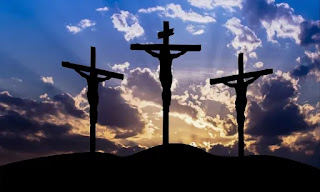The Story - The Sacrifice
The moment that Jesus has predicted has come. Judas slips out of the dinner room after Jesus gives him the "go-ahead," so to speak—Jesus's foreknowledge extends to him telling Judas, "What you are going to do, do quickly."
With that, Judas is gone. He makes his way to the Pharisees and tells them that he'll lead them to where Jesus is, for the payment of 30 silver coins. 30 silver coins would be worth just under $200 in today's money, according to this blog post—the Savior of the world, sold for a pittance.
Meanwhile, Jesus has taken some of his closest disciples to the Garden of Gethsemane to pray. He needs the strength. Prayer isn't just an option for Jesus; it's how he speaks to his Father, and it's an intimate and personal conversation. It's necessary. And Jesus knows that the night ahead is going to be the longest in his life.
Jesus asks his disciples to stay awake and pray with him. But as they're weak and tired, they fall asleep. Jesus is left alone with God, and he pleads with him over and over for hours. "Father, take away this cup from me," he says, followed by a humble admission: "Yet not what I will, but what you will."
Even in his darkest hour, Jesus does his Father's will. And he knows exactly what will happen.
Coming back to find his disciples sleeping, Jesus wakes them and rebukes them for their weakness—but it's at that very moment that Judas strikes. A crowd with swords and clubs comes into the garden, and Judas approaches Jesus and kisses him in greeting, in traditional Hebrew fashion.
It's a mockery. The kiss was the appointed signal for the Pharisees to take him—but as they try, they find that they can't. Indeed, they find they're thrown to the ground at his very voice. But Jesus goes with them willingly, saying "let the Scriptures be fulfilled."
The prophecies of the sacrificial lamb are beginning to be more clear.
Deserted by his disciples (they've all fled at the sight of their Savior being taken away), Jesus is taken to the high priest. There, he's subjected to a horribly fake trial consisting of several "witnesses" who claim that Jesus blasphemed against Hebrew law. Their stories don't agree with each other. The narrative they paint is inconsistent. According to the principles that Moses set up a thousand years ago, Jesus should have been set free with an apology for the barbaric way his trial went.
But Jesus is condemned instead. And the crowd brings him to the local Roman authority, Pilate, so that he can legally be executed.
Pilate doesn't quite understand the problem here; he doesn't see Jesus as guilty of anything, and so decides to release him. But the crowds are insistent. "Crucify him!" they shout, calling for his death.
So Pilate is swayed by the crowd in the interests of keeping the peace. And he delivers Jesus up to be crucified.
Jesus is beaten with a scourge. He has thorns pressed into his scalp in the shape of a crown. He is spit upon, and mocked. The wine they give him to drink is laced with myrrh, a spice used to preserve dead bodies; it's like they're telling him that soon, he's going to need those spices himself.
He is given a heavy wooden cross to carry up to the place of execution. But since by this point he is too weak to carry it, they grab a random observer from the crowd and make him take it instead. In this manner, they proceed to Golgotha, the Place of the Skull.
Crucifixion is the method of execution where the victim is nailed, hands and feet, to two pieces of wood formed in a cross shape. As the victim tries to breathe, they become weaker and weaker, since with every breath they must pull themselves up by their hands. Eventually, they die of asphyxiation, but only after a long drawn-out process.
This is what the Romans are going to do to Jesus.
As Jesus hangs on the cross, pulling himself up and down with every breath, he has opportunity to speak. What does he say?"Father, forgive them," he gasps out, "for they know not what they do."
Forgive them.
Even in the midst of such intense suffering, Jesus's primary thought is the forgiveness of his executioners. Never has "love your enemies, pray for those who persecute you" been so clearly shown.
His enemies don't particularly care to be forgiven, though, and continue jeering at Jesus. "If you're so powerful, why don't you come down from there?" they challenge. "Then we'll believe you're the Son of God. Give us a sign! Prove it!"
But Jesus doesn't. Because he is the lamb for the sacrifice, and the lamb must die.
Finally, at 3:00 in the afternoon on Friday morning after a long, arduous period of agonizing torture, Jesus dies.
They take his body down. They wrap it in the white burial shroud, weeping and mourning. Is this what their Savior has done for them? This corpse, is this really Jesus?
And they lay him in the tomb on Friday evening. The next day is the Sabbath, on which no work can be done.Satan rejoices, because he has killed the Son of God.
It is finished.




WOW. This is really really powerful. Thank you, Emma!
ReplyDeleteThank you :)
DeleteI agree, this is powerful, and timely too! It has so many facts in it I didn’t know before, like that myrrh is used on dead bodies. All of those little details make the story that much more amazing!
ReplyDeleteOh hey, foreshadowing! 😉
Delete